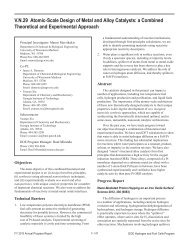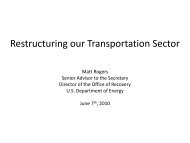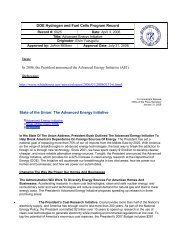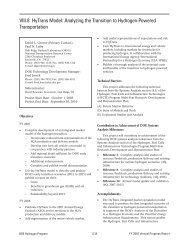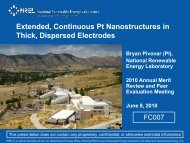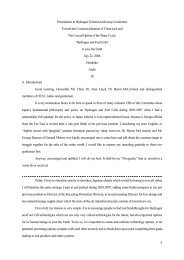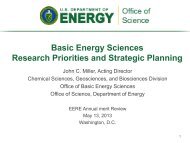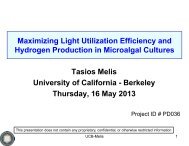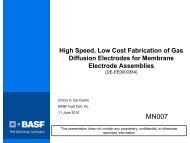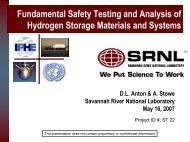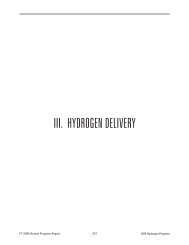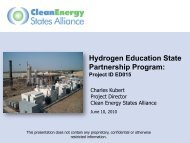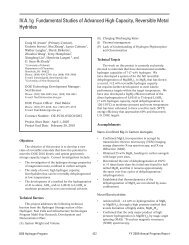Fuel Cell System for Transportation -- 2005 Cost Estimate
Fuel Cell System for Transportation -- 2005 Cost Estimate
Fuel Cell System for Transportation -- 2005 Cost Estimate
Create successful ePaper yourself
Turn your PDF publications into a flip-book with our unique Google optimized e-Paper software.
Introduction<br />
The U.S. Department of Energy (DOE) Hydrogen, <strong>Fuel</strong> <strong>Cell</strong>s and Infrastructure Technologies<br />
Program Manager asked the National Renewable Energy Laboratory (NREL) to commission an<br />
independent review of the <strong>2005</strong> TIAX cost analysis <strong>for</strong> fuel cell production. The NREL <strong>System</strong>s<br />
Integrator is responsible <strong>for</strong> conducting independent reviews of progress toward meeting the DOE<br />
Hydrogen Program (the Program) technical targets. An important technical target of the Program is<br />
the proton exchange membrane (PEM) fuel cell cost in terms of dollars per kilowatt ($/kW). The<br />
Program’s Multi-Year Program Research, Development, and Demonstration Plan established<br />
$125/kW as the <strong>2005</strong> technical target.<br />
Over the last several years, the Program has contracted with TIAX, LLC (TIAX) to produce estimates<br />
of the high volume cost of PEM fuel cell production <strong>for</strong> transportation use. Since no manufacturer is<br />
yet producing PEM fuel cells in the quantities needed <strong>for</strong> an initial hydrogen-based transportation<br />
economy, these estimates are necessary <strong>for</strong> DOE to gauge progress toward meeting its targets. For a<br />
PEM fuel cell system configuration developed by Argonne National Laboratory, TIAX estimated the<br />
total cost to be $108/kW, based on assumptions of 500,000 units per year produced with <strong>2005</strong> cell<br />
stack technology, vertical integration of cell stack manufacturing, and balance-of-plant (BOP)<br />
components purchased from a supplier network. Furthermore, TIAX conducted a Monte Carlo<br />
analysis by varying ten key parameters over a wide range of values and estimated with 98% certainty<br />
that the mean PEM fuel cell system cost would be below DOE’s <strong>2005</strong> target of $125/kW.<br />
NREL commissioned DJW TECHNOLOGY, LLC to <strong>for</strong>m an Independent Review Team (the Team)<br />
of industry fuel cell experts and to evaluate the cost estimation process and the results reported by<br />
TIAX. The results of this independent review will permit NREL and DOE to better understand the<br />
credibility of the TIAX cost estimation process and to implement changes in future cost analyses, if<br />
necessary.<br />
<strong>Cost</strong> Analysis Assumptions<br />
DOE determined many of the top-level assumptions, in consultation with the FreedomCAR and <strong>Fuel</strong><br />
Partnership <strong>Fuel</strong> <strong>Cell</strong> Technical Team (Tech Team), which were used by TIAX in its analysis. Lower<br />
level assumptions were developed by TIAX, as required, and are described herein when they are<br />
important to understanding the overall results.<br />
<strong>Fuel</strong> <strong>Cell</strong> Configuration: DOE requested that TIAX analyze an 80-kWnet direct hydrogen PEM fuel<br />
cell system which includes the fuel cell stack and balance-of-plant (BOP) components <strong>for</strong> air, water,<br />
thermal, and fuel management, but not the hydrogen storage and power conditioning, since the latter<br />
are not included in DOE’s $125/kW target. DOE provided TIAX access to a PEM fuel cell system<br />
configuration and model developed by Argonne National Laboratory (ANL). The ANL model<br />
provides the basis <strong>for</strong> specifying the overall system, subsystem, and component per<strong>for</strong>mance<br />
parameters and the fluid and electrical interfaces.<br />
The TIAX cost analysis uses representative component designs, manufacturing processes <strong>for</strong><br />
components, the development of a bill of materials, and list of purchased components. The model,<br />
data, component designs, and results were refined on the basis of recommendations from DOE, the<br />
Tech Team, and fuel cell system and component developers.<br />
Figure 1 shows the major components of ANL’s PEM fuel cell system configuration.<br />
subsystems include:<br />
The BOP<br />
-1-



